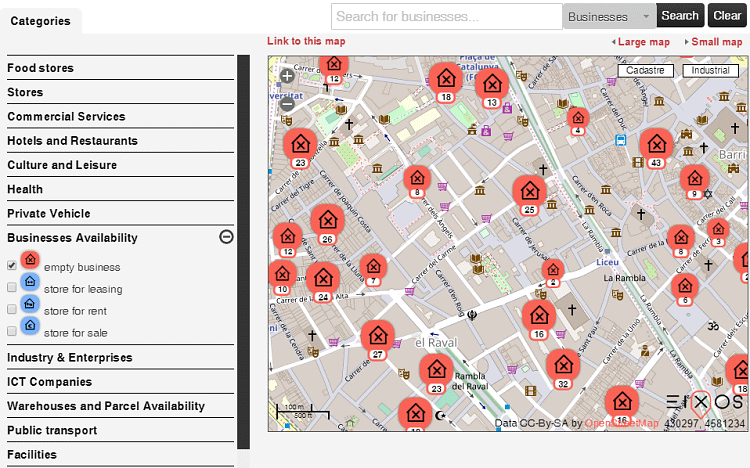Barcelona: interactive commercial street map. All retail, services and empty businesses
EIXOS Economic Observatory is an information service that maps and classifies urban commerce, closed premises, businesses, industrial activities, empty or closed warehouses and equipment, administrative buildings and public transport. Numerous map layers of economic activity include clothing stores, hardware stores, florists and restaurants. Commercial and industrial uses of individual buildings are identified through regular fieldwork combined with other sources, mainly Open Data. Census data based on more than 300 economic indicators allow the publication of two maps per year, in winter and summer.
The Economic Observatory also provides two indicators, the Commercial Fabric Utilisation Index (IATC) and Commercial Attraction Index (IAC). These may be used in an evaluation of the health and vibrancy of Barcelona's shopping centres and high streets.

El Raval, Barcelona: empty businesses 10 January 2020
Click image to open map
Commercial Fabric Utilisation Index (IATC)
The Commercial Fabric Utilisation Index (IATC) measures the percentage of active commercial premises, out of the total commercial premises available in a given commercial area. An IATC of 80% indicates that, of the total commercial premises available in a given commercial area, there are 80% of commercial premises with recognized activity, and 20% of empty or closed premises with no apparent activity. Having performed a comparative analysis in more than 200 Catalan cities, the observatory has established that 80% defines a certain critical point from which the commercial fabric undergoes substantial changes. An IATC below 80%, in a given commercial area, indicates that the commercial area is depressed, with a presence of 20% or more of closed or empty premises.
Commercial Attraction Index (IAC)
The Commercial Attraction Index (IAC) calculates the percentage of businesses with economic activity considered non-day-to-day with respect to the total number of commercial activities in a given commercial area. Non-day-to-day economic activities would be those carried out by all shops that sell products that are not essential, but are of value to the welfare of potential consumers. These consumers would be willing to travel from their area of residence in order to acquire them.
![]() Economic Observatory Case study: A comparative analysis of tourist impact on trade: Platja d'Aro and Barceloneta
Economic Observatory Case study: A comparative analysis of tourist impact on trade: Platja d'Aro and Barceloneta
